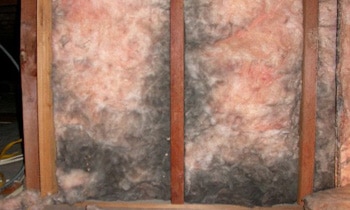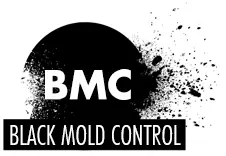Do you have black mold on insulation? Also known as Stachybotrys chartarum, black mold occurs where there is moisture as it’s required for its growth. Accordingly, the source of the problem needs to be addressed (e.g., water damage, flooding). And, of course, it must be removed. As the CDC puts it, “All molds should be treated the same with respect to potential health risks and removal.”

As we’ll discuss, however, black insulating material might simply be a matter of air leaking from your house, discoloring the insulating material black.
Table of contents
Basics of mold growth
Crucial to the ecosystem, these fungi play a crucial role in the decomposition of organic materials, making nutrients available in the soil. However, the problem arises when such spores grow indoors, feeding on insulating materials such as cotton. Growing in the form of multicellular filaments, mould is fungi and needs moisture to grow. It reproduces through the production of spores. Such spores end up airborne. Inhaled into the lungs, such spores pose the risk of respiratory issues. Learn more about mold growth.
What mold needs to grow
As pointed out by the EPA, “Mold can grow on virtually any organic material as long as moisture and oxygen are present.”
Such materials include:
[su_list icon=”icon: angle-right” icon_color=”#000000″]
- Insulating material
- Wood
- Food
[/su_list]
And wet wood is indeed a serious concern, posing the risk of structural damage. Such damage to the wood can, in fact, weaken floors and walls.
There is also a type of fungi known as mildew. Unlike mold that appears in various shades of colors, this fungi is white. It has been especially known to grow in the bathtub—an environment that provides the humidity for it to thrive.
Which types of insulation can be affected by black mold?
For black mold to grow, as noted, three things must be present: biodegradable material, air, and moisture. Biodegradeable material ranges from paper to cotton–substances the organism will feed on.
Fiberglass insulation
Since biodegradable material needs to be present for spores to grow, the ground glass does not accommodate growth. Accordingly, it’s impossible for spores to grow on the ground glass of fiberglass insulation. In general, this makes it a great option to avoid spore growth. That said, it can grow on the backing.
This makes fiberglass without backing a viable option for those looking for a resistant material.
Spray foam
Often manufactured as spray polyurethane foam (SPF) spray foam is both an insulating material and an air barrier. It’s often used around window frames.
Coming in either of two forms (i.e., open cell, closed cell), it’s necessary to ensure that the foam is sufficiently thick and properly aligned to block any air flow.
Fortunately, spray foam is resistant to the growth of spores.
Blanket batts and rolls
Coming in precut rectangular batts or rolls,blanket insulation is commonly used in attics. They’re typically constructed with fiberglass, although versions made of cotton, mineral wool, and plastic fibers are also available.
Cotton insulation
For those who believe in going green, cotton insulation is an appealing choice. Not only is it an effective insulator, but it is manufactured out of a renewable resource. However, being biodegradable, this insulating material is just as appealing to mold.
Blown-in insulation
Also known as loose-fill, blown-in insulation uses pneumatic equipment to blow particles into an attic, usually where no insulating material has ever been installed. Such particles consist of one of three materials.
- Fiberglass
- Mineral Wool
- Cellulose
It is made up of loose particles that are blown into an attic or into wall cavities, which are the spaces between the interior and exterior walls of a building. Since even distribution of the material is important, and because special pneumatic equipment is required, installation is usually done by a professional.
Foam board insulation
Foam board insulation is rigid panels of insulating material that are made of either polystyrene, polyisocyanurate, and polyurethane, according to the U.S. Department of Energy. Foam board can be used to insulate any exposed cavity in your home from the top to the bottom, and even the walls if you are remodeling and the drywall is down.
Reflective insulation
Reflecting radiant heat instead of absorbing it, reflective insulation, or radiant barrier, helps reduce energy costs. Plus, its material isn’t prone to mold growth nor degradation. Thus, a radiant barrier is a fine long-term answer for your insulation needs.
Wood fiber insulation
Known as a natural insulator, the cellular structure of wood contains air pockets. As a result, wood fiber insulation is another popular choice.
Paper backed insulation
As we’ve discussed the paper backing enables mold to grow on the otherwise mold-resistant ground glass that fiberglass insulating material is manufactured out of. Such paper is a biodegradable material that the organism feeds on.
So, buy the insulating material without backing for mold prevention. After all, the prevention of a problem is less frustrating and less expensive than the treatment of it.

How to detect black mold on insulation?
Yet black insulating material, as we’ve mentioned, is not necessarily black mold. Air leaking from your house can discolor the fiberglass. This is because the air is carrying particulates and moisture, turning the fiberglass black. If this turns out to be the case, the root of the problem must be addressed with caulk or canned foam.
How to remove mold from insulation?
First and foremost, address the root of the problem before reinstalling the insulating material. Otherwise, the underlying issue (e.g., leak) will only cause fungi growing on the new insulating material as well.
While it’s advisable to call a professional if you do decide to remove and control it yourself, be sure to do it safely. For instance, you’ll want to wear safety goggles, glasses, and a half-face respirator. You’ll also want to utilize drop cloths and bleach.
Lastly, ensure you dispose of all the spores properly. In reality, calling a professional is your best option though.
Mold-resistant insulation
We’ve discussed mold-resistant insulating material, ranging from backless fiberglass to spray foam. The bottom line though is that all homeowners want a sealed home. You want to seal out everything from a draft to rodents.
And, as we all know, well-installed insulating material can save you and your family money on energy costs. But, as we’ve mentioned, when moldy it can pose a danger to our respiratory systems.
Mold prevention tips
If you can just prevent the problem, buying a material resistant to fungi growth, a resistant problem that will save you a lot of time and effort in the long run. You’ll be so glad you did.
When to consult a mold remediation expert?
Lastly, if you’ve identified black mold, call a professional. Better to call and it is not a true problem, then to not call and it is one. Stay on the safe side. However, as we’ve discussed, prevention of the problem (e.g., buying insulating material without paper backing is your best bet.
Plus, you want to identify the issue and resolve it early on. For instance, black mold in the attic left unchecked can spread throughout the house, posing a risk to your family’s health.
